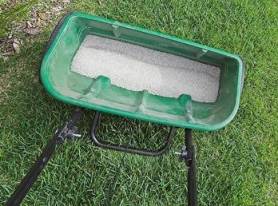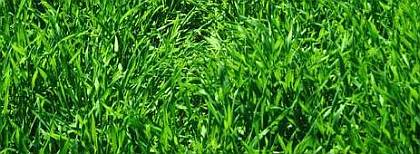FERTILIZER NUMBERS:
What Do They Mean?
Learn How Fertilizer Numbers
Can Help You Get Better Value.
Pick up a bag of fertilizer on sale. Good job. You saved some money!
Or did you…
How can you tell if you got your money’s worth? There is such a broad range of prices when you look at the fertilizer options.
What exactly did you buy, and what is its best use?
You want a good dollar value. You also want the product that will produce the best results.
Understand the significance of fertilizer numbers, or N-P-K ratios, and you can have both.
A bag of fertilizer on the garden department shelf is a "Marketing Masterpiece". Each brand promises to be the perfect match for your lawn.
Contrast that with a bag bought by the professionals lawn care guys at their wholesale dealer. Plain and simple. It gives a formula (the fertilizer numbers) and a list of ingredients. Is that enough to make a decision?
Yes… if you know what you’re looking for.
FTC Disclosure:
If you make a purchase via a link on this site, I may receive a small commission on the transaction - at no added cost to you.
Sponsored Links
WHAT ARE N - P - K
& What Are Their Roles In Fertilizer?
All fertilizers use a three number rating system, like 15-15-15, or 21-7-14. (There is an exception to this, a fourth number, explained at the bottom of this article.)
The first number represents Nitrogen, the second is Phosphorous, the third is Potassium (or Potash). These numbers are percentages of the total ingredients in the bag. (In case you forget the order, the words are alphabetical, although the letters are not!)
Want to sound like a pro? The chemical notations of these elements are N-P-K, a very official designation for fertilizer numbers. Use this term when you shop and impress someone! Triple 15 (15-15-15) has equal amounts of each of these nutrients, or 15% of each. (Triple 16 is almost identical.)
This is how fertilizer ratios work. For an example, let's use fertilizer numbers with an NPK rating of 21-7-14.
Nitrogen has the highest concentration at 21%.
It is 3 times the amount of phosphorous at 7%.
Phosphorous at 7% is only half of the Potassium amount of 14%.
Technically, this would be called a 3-1-2 ratio.
A math teacher might try to give you a real life algebra lesson at this point, but let’s not go there.
Instead, use this simple trick that will help you identify the proper blend each time you need to buy lawn fertilizer.
Look at any set of fertilizer ratios on a label. Notice how the numbers relate to each other by size:
- 21-7-14 is Big - Small - Medium
- 21 -3 -3 is Big - Small - Small
- 6 -20-20 is Small - Big - Big
- 21 -0 -0 is Big - Zero - Zero
The N-P-K rating you want for grass typically is Big - Small - Small.
If you follow this, you see that grass needs a lot of Nitrogen and a little bit of the other stuff. That’s the essential part.
If you’re willing to learn about what these nutrients do, you can vary your selection based on your specific lawn situation.

WHY DO THE FERTILIZER NUMBERS MATTER?
A brief description of each major nutrient will show why grass has its own preference for fertilizer.
NITROGEN:
- essential for growth of foliage;
- produces lush, tender, green leaves (or grass blades);
- deficiency results in a yellow-green color (chlorosis) and little or no growth;
- is easily flushed through the soil.
PHOSPHOROUS:
- stimulates root growth;
- hastens the maturity of plants;
- promotes development of flowers, fruits, seeds;
- deficiency can result in slow or stunted growth and purplish discoloration on leaves;
- remains in the soil quite well.
POTASSIUM:
- gives vigor to tolerate changing weather conditions;
- helps resist disease;
- assists in the food manufacturing process;
- strengthens cell wall structure for strong stems;
- deficiency can cause week stems and slow growth;
- leaches from the soil, not so fast as nitrogen.
HOW CAN THIS SAVE YOU MONEY?
Look at the current status of your lawn.
AN ESTABLISHED LAWN:
needs primarily nitrogen, since it is not producing any fruit or flowers, so get Big - Small - Small.
Nitrogen is the least expensive of the nutrients. Don’t buy a formula that has high levels of phosphorous or potassium when you don’t need them.
A NEW LAWN:
is special and needs more phosphorous to produce roots. Don’t use high nitrogen because the roots are not ready to handle top growth. Go with Small - Big - Big.
Phosphorous and potassium are more costly, so you would not use this all the time. Yet, investing in the more expensive list of ingredients for a new or damaged lawn is wise.
NEW SOD:
Be safe when you fertilize new sod! It looks like a mature lawn, but the roots have been shaved off and it needs to recover. Save the expense of redoing this huge project. You can kill the young lawn with the wrong blend. Avoid stress and later expensive problems by helping the grass get established properly.
Use Small - Big - Big or Zero - Big - Big.
(Be aware that many sod growing farms apply an appropriate fertilizer shortly before they harvest, so it is good to inquire about that before you purchase. Other sod sellers will furnish a bag of sufficient quantity for you to apply.)
A STRESSED LAWN
from many conditions, like recovering after insect damage, preparing for winter or extreme heat needs more potassium.
Try Big - Small - Medium or Big - Small - Big
When the grass has stressful conditions to deal with, applying the more expensive potassium can prevent problems from developing or continuing. Pay now and don’t pay later.
Thus, if the fertilizer with higher numbers in the ratio is on sale, and your lawn would benefit from those nutrients, then you can apply it with confidence, knowing you got a good deal.
Be cautious though, about applying high phosphorous continually to a lawn area. Mature grass doesn’t need it, and the environment doesn’t either.
SPECIAL NOTE:
Most states now restrict or eliminate the application of phosphorous on lawns, to decrease pollution from run-off.
A new lawn may be exempt from restriction, considering that it needs more phosphorous to stimulate quick root growth.
(Check with your local regulatory agencies or a specialty nursery.)
IS THE FERTILIZER NUMBER RATIO
ALL THAT MATTERS?
The nutrient ratio is easy to look at. It can help you decide quickly to consider or eliminate certain fertilizer blends. It is not the only factor deserving of your attention.
Consider learning about the ingredient source that provides the NPK. In addition, the way the fertilizer pellets are manufactured can also affect the value and life-span of the nutrients. Sound too technical?
Check out another simple overview that could save you time and trouble by applying the plant food less frequently. Follow this link to get the details: Learn About Chemical Fertilizer.
A FOURTH FERTILIZER NUMBER?
This question from a reader explains the exception to the three number label.
READER'S QUESTION:
I was given a bottle of fertilizer labeled 0.2.0.0. I think it's .02% N. But I have never seen this before.
Garden Counselor REPLY:
Let me offer one assumption different from your idea, plus a way to check it out.
Typical fertilizer labels present only 3 numbers, as you are probably aware. They are always in this order: nitrogen, phosphorous, potassium. So it does appear that your expectation of getting .02% or 0.2% nitrogen is a reasonable possibility, with the way the numbers are presented. But then the remainder of the nutrient numbers can not be properly interpreted the way it is displayed.
Here is the likely alternative. Occasionally a fourth nutrient number is added to a fertilizer formula. Manufacturers will sometimes want to promote a particular fertilizer by denoting that it contains a significant portion of an important trace mineral. When a value is included for the fourth number, it must be specified what that nutrient is, by name. Common entries for this fourth number refer to the presence of sulphur or iron or zinc.
Knowing this, we should suspect that the product you have is:
0% nitrogen / 2% phosphorus / 0% potassium / 0% trace minerals
Why would they add a fourth number on the label, if it is zero? Simply because they produce some products which do use the #4 slot, so it standardizes their operation to show it, even when it is zero.
So you need to look at the detailed part of the label that lists the actual ingredients. I expect you will see some form of phosphorus listed. If it were nitrogen, you would likely see that some type of nitrate or urea is included.
If that portion of the label is missing or not legible, i would discourage the use of the product, to avoid any unintended consequence.
Sponsored Links


|
Go to Top of Page Go to Lawn Fertilizer general information page Go to Lawn Care Home Page |

BRING ON SPRING!
A Stronger, Greener Lawn
Starts Now...
with help from DoMyOwn
Products * Videos * Schedules * Guides